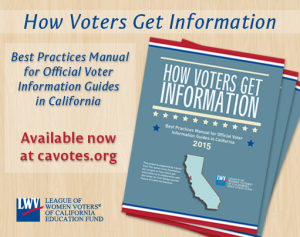February 25, 2015
In
the November 2014 election, only 31% of eligible Californians voted and young
people and people of color continued to be underrepresented. Although many
factors contribute to low voter turnout, we believe that voter information is
an important tool to engage and expand the electorate.
To
help make voter information more effective, more inviting, and more useful, we
have released our Best Practices Manual
for Official Voter Information Guides. This manual was specifically developed as an easy-to-use
resource for election officials and community groups working to enfranchise and
educate California voters.
- Download the Manual
- View a prototype voter guide
- View a sample Voter Bill of Rights written in plain language
What is in the Best Practices Manual for
Official Voter Information Guides Manual?
To
better serve California’s diverse voters, this manual provides a full checklist
of recommendations for creating or reviewing a voter guide to help answer the
questions voters need. We must effectively provide voter information that:
- bridges civic literacy gaps
- is designed to make information easy to read
- is written in a language voters can understand
We
hope that using our recommendations will lead to voter guides that raise voter
confidence and increase participation. Some of these ideas are already being
implemented in one or more California counties. While we suggest several simple
fixes, some ideas may face regulatory, legislative, and financial barriers—a
challenge we welcome to better serve California’s diverse electorate.
How can I get more information on how
to use the manual?
View the webinar recordings and download the presentations from April 27 and May 1. Trainings and webinars provide technical assistance in
implementing voter guide recommendations. Sign up for our newsletters and like us on Facebook to get all the information you need.
Where did the research come from?
Our
research, led by the Center for Civic Design, was informed by diverse
stakeholders, including election officials, community organizations, good
government groups, and frequent and infrequent voters from across California.
The voices of these voters underpin all our conclusions and recommendations.
One of these voices included a bilingual, low-literacy
research participant who stated, “The whole time I’ve been ignoring this book,
and it had all this information inside. Now that I’m reading it, it makes me
feel more confident.”
Who funded this
project?
This project is supported by a grant from The James
Irvine Foundation.
Questions?
Contact us via email at lwvc at lwvc.org.

